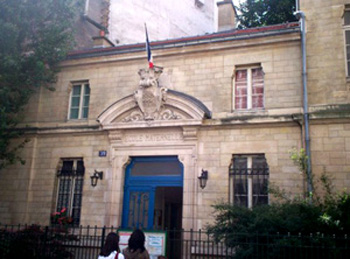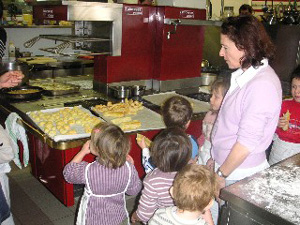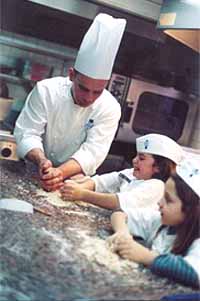 |
Formation of Children
Training the Palate in France
Marian T. Horvat, Ph.D.
What could be more socialist than the pre-school system in France? The state-run, free maternelle schools – which are anything but maternal, since they replace a mother’s loving care with a sterile preschool environment – accept children from aged 2 to 5. It is not compulsory (yet), but almost 100% of children aged 3 to 5 already attend it. I believe it is the kind of model program the United States is heading toward.

Entrance of a public pre-school in Paris |
Even in this horrible socialist program, however, there is still something that reflects the France of old, Catholic France, the firstborn daughter of the Church. A remnant of its great culinary tradition remains - even in the secular education system.
Am I making a concession to Socialism by pointing this out? I don’t believe so. St. Paul teaches us to examine all things, and hold fast to that which is good (1 Thes 5: 2). Here I am following his advice.
The old France of the ‘bon appetit,’ renowned for its refinement of taste and assortment of table, may be fading but it is certainly not completely gone. One need only check the menu of the typical French preschool classroom to realize the French still retain some sense of pride in their famous culinary past and desire to pass it on to future generations.
Here is an actual French state-run preschool menu for 2 to 5 year-olds – served in different courses:
- French onion soup;
- Crab-stuffed avocadoes or puff-pastry appetizers (bouchées à la reine)
- Chicken breasts with white wine, cream sauce and stuffed mushrooms and aligot (melted Tomme cheese blended into garlic mashed potatoes);
- Salad;
- Cheese;
- Chocolate mousse or chocolate éclairs,
- Café au lait (coffee with milk) after the meal.

A typical American lunch for preschoolers that nourishes only body not the soul |
Now, please compare the above to a typical lunch in an American preschool, which I am not inventing, but taking from an actual menu. On Mondays, this is served:
- Corn Dog, mixed vegetables, pear, milk.
On Wednesdays, the children have the following:
- Peanut Butter & Jam Sandwich, banana, macaroni salad, milk.
Then, there is the typical Taco Tuesday or Pizza Friday…
I believe that a simple comparison of the menus speak volumes about our different cultures.
Educating the palate
Recently a National Public Radio reporter visited the La Margeride day care in Paris. She found not one, but two professional cooks in the kitchen at 9 a.m., already beginning preparation of the lunch meal with fresh food and vegetables evident on the counters. Nothing mass-produced, no frozen packages of chicken nuggets or tater tots.
That particular day, Chef Elizabeth Morel was chopping garlic and onions to season the braised lamb in fresh rosemary, while fellow Chef Martine Belaud peeled tomato skins to fashion decorative roses for the pasta-salad appetizer.
Morel affirmed the value of decorating dishes for 2-year-olds: “It builds their appetites, and they love it when we decorate. Presentation is very important. Before tasting, you look. So, when you see something nice, you want to eat it." (1)

French toddlers learn and sample at a pastry-making demonstration |
Very French, and very civilized, I might add.
Who could imagine serving savory lamb, cauliflower au gratin and rose tomato garnishes to preschoolers in the United States? And if by some chance we did, I’m afraid much of it would be in the trash at the end of the meal. Perhaps if we would try to serve such meals on a regular basis, children would develop more refined palates and be willing to venture beyond the low horizons of corn dogs and pizza. I think they would.
The French believe that children must learn very young to find delight in tasting food. Cuisine is part and parcel of the education. Chefs give classes on presentation to school children and schools participate in programs to “awaken the palates.”
Not surprisingly, with the cultivation of taste comes the natural cultivation of manners. The preschoolers are encouraged to use their silverware, reminded to say please and thank you, and to sit up straight in their chairs. They are not allowed to leave the table until the full meal is completed.
Sandra Merle, a dietician for the Paris day care system, emphasizes that it is important to start young to lay the foundations for a lifetime of healthy eating. "These lunches help children develop the potential to enjoy a proper sit-down meal with an appetizer, main plate, cheese and a dessert while taking their time in a convivial atmosphere," she says. (2)
Let me stress again that these are not schools for the aristocrats of France. We are talking about the normal public school for children of the lower and middle classes.
Two mentalities
Of course, some readers might protest, the French must have more funds available for their preschoolers, while here in the U.S. we have to be more economical.

A Chef teaches children to cook |
First, I don’t believe that it is economics that dictates the standards of culture. The table of a simple Catholic peasant of the last century would far outshine in quality and excellence the standard middle or upper-middle-class American table of the 20th century. Second, a price-per-plate comparison actually refutes that argument. The average minimum today in the United States to prepare a hot lunch like the one cited earlier is $2.66. (3) The preschooler lunch in France cited above costs about $2 per meal per child… (4) So, we pay more to eat much worse.
Someone might protest that such an elaborate, rich menu would result in quite chubby children. To the contrary, it is the American children who are becoming increasingly obese thanks to their artificial, processed food diet. The French correctly believe that by teaching children to enjoy real food served in courses and in a convivial but gentile atmosphere, it will help prevent obesity. Their children are not fat.
In short, the comparison serves the purpose of presenting a picture of two mentalities of society regarding food. In the U.S. menu, we see standardized foodstuff produced to serve a mass market. In the Paris menu, we can see that food still reflects the personality and values of a Catholic people and culture. In short, in that menu there is the notion that food should feed not only the body but also the spirit.
1. “In Paris, Culinary Education Starts In Day Care,” NPR Morning Edition online, February 16, 2009
2. Ibid.
3. “High Food Costs land on School lunch trays,” msnbc online, June 9, 2008
4. “In Paris, Culinary Educaiton Starts in Day Care,” ibid.

Posted March 4, 2009

Related Topics of Interest
 Eating Alone Eating Alone
 Fast Food Is Protestant Fast Food Is Protestant
 Manners Make Life Easier Manners Make Life Easier
 Courtesy in the Catholic Home Courtesy in the Catholic Home
 Essential Table Manners Essential Table Manners
 A Youth's Relations with His Superiors A Youth's Relations with His Superiors
 What America Eats What America Eats

Related Works of Interest
|
|
Formation | Cultural | Home | Books | CDs | Search | Contact Us | Donate

© 2002- Tradition in Action, Inc. All Rights Reserved
|
 |
|